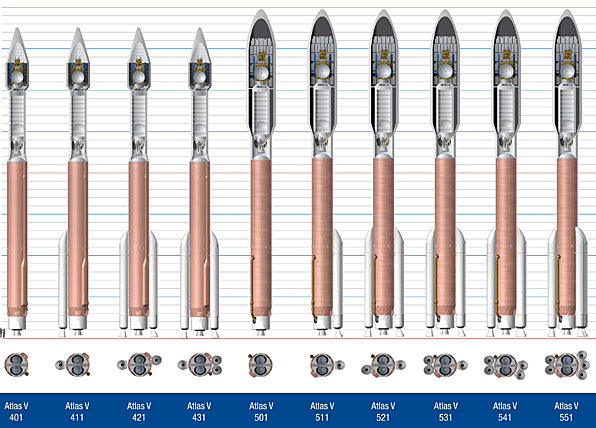Atlas/DMSP F19 information sheet
A United Launch Alliance Atlas 5-401 rocket (AV-044) will be used to launch the Defense Meteorological Satellite Program Flight 19 military weather satellite for the U.S. Air Force. The polar orbiting satellite will collect global data on cloud movements, atmospheric profiles and the other ingredients needed by meteorologists to generate strike quality weather forecasts across the globe for the warfighter. The rocket stands 189 feet tall, weighs 737,000 pounds at launch and produces 860,000 pounds of sea-level thrust. The spacecraft is encapsulated in a 14-foot, diameter, 39-foot-tall aluminum payload fairing.
The rocket launching DMSP F19 was born of the Air Force's commercial competition to develop next-generation Evolved Expendable Launch Vehicles. It has flown 43 times since debuting in 2002, carrying out 15 flights dedicated to the Defense Department, 11 missions for NASA, nine flights with commercial payloads, and eight with spy satellites for the National Reconnaissance Office. Atlas 5 was built to be more robust and reliable over earlier Atlas and Titan heavy-lift vehicles, and streamlined production has resulted in fewer opportunities for human error. The launcher builds upon the success of its predecessors, using the Russian-made RD-180 main engine, a stretched Centaur upper stage and its RL10 engine that were proven during the Atlas 3 program. The key piece that sets Atlas 5 apart, however, was the rigid body Common Core Booster serving as the rocket's first stage. The CCB replaced the "balloon" pressure-stabilized stage used by previous Atlas vehicles. As the CCB's name suggests, the stage is common and is used in all the various configurations of the Atlas 5 family. The booster stage is 106.6 feet long and 12.5 feet diameter.
There are two distinct types of Atlas 5 rockets -- the 400 series and 500 series -- each tailored to launching a certain class of satellite. The 400 series uses a four-meter diameter payload shroud and has flown 28 times. The 500 series, distinguished by a five-meter fairing, has launched 15 times. To match an Atlas 5 with the size of its payload, up to five solid rocket motors can be strapped to the rocket to give extra boost at liftoff and the two different types of nose cones are available to enclose the satellite atop the launcher. The various options give Atlas 5 the nickname "dial-a-rocket" because of its flexibility. Powering the Atlas 5 during the first four minutes of flight is the RD-180 liquid-fueled engine. The liquid oxygen/kerosene powerplant is a two-thrust chamber, two-nozzle engine made by NPO Energomash of Khimky, Russia. It was developed from the RD-170 engine used by Russia's Energia-Buran space shuttle, the Energia-M and Ukrainian Zenit rockets. Featuring hypergolic ignition, the engine produces 860,000 pounds of thrust and is throttled up and down to ease the stresses the rocket experiences throughout the launch. And its dual nozzles provides superior steering control during the climb out.
The American propulsion firm Aerojet Rocketdyne financed the development of the RD-180 for the Atlas program. NPO Energomash is a partner of RD AMROSS, the joint venture formed to market, sell and distribute the RD-180 engines. The workhorse Centaur upper stage has flown in various configurations for decades. For this launch, the stage will use one Aerojet Rocketdyne-built RL10A-4-2 liquid oxygen/liquid hydrogen engine that develops a thrust of about 22,300 pounds. The Centaur will fire three times during ascent, initially boosting itself and attached satellite into a parking orbit around Earth after separation from the first stage. A second burn then propels the payload into a highly elliptical geosynchronous transfer orbit, followed by a long coast phase before a final push is delivered to raise the orbit's low point and reduce inclination relative to the equator. The stage is 41.5 feet in length and 10 feet it diameter. It also houses the navigation unit that serves as the rocket's guidance brain.
Atlas-Centaur rockets have been used since the 1960s to dispatch ground-breaking missions for NASA, including the Surveyors to the Moon, Mariner flights to Mars, Venus and Mercury, and the Pioneers that were the first to visit Jupiter and beyond. In its newest era, the Atlas 5 rocket sent the Mars Reconnaissance Orbiter to the red planet in 2005, propelled the New Horizons probe toward Pluto and the solar system's outer fringes in 2006, doubled up with the dual Lunar Reconnaissance Orbiter and LCROSS impactor to the Moon in 2009, hurled Juno to Jupiter in August 2011 and dispatched the car-sized Curiosity rover on the Mars Science Lab mission in November 2012 and the Mars-bound MAVEN orbiter this past November. Ground Track Map
The Atlas 5 will use a single-burn mission to deliver the DMSP F19 spacecraft into a sun-synchronous polar orbit. The targeted orbit is: 852.8 km (530 statute miles) x 852.8 km (530 statute miles) circular orbit at an inclination of 98.87 degrees. T-00:02.7...RD-180 Engine Ignition +00:01.1...LIFTOFF T+00:17.1...Begin Pitch/Yaw/Roll Maneuver T+01:25.7...Maximum Dynamic Pressure T+04:04.6...Atlas Booster Engine Cutoff (BECO) T+04:10.6...Atlas Booster/Centaur Separation T+04:20.4...Centaur First Main Engine Start (MES-1) T+04:28.6...Payload Fairing Jettison T+15:39.4...Centaur First Main Engine Cutoff (MECO-1) T+18:28.4...DMSP F19 SEPARATION Atlas 5 FactsThis will be:
The DMSP SatelliteFor 52 years, the Defense Meteorological Satellite Program is the longest running satellite production ever. Unlike the civilian geostationary satellites parked 22,300 miles above Earth to focus on one region of the planet and capture the imagery of clouds seen on television weather reports, the military's DMSP satellites fly far closer to the ground and see virtually the entire globe twice daily. The orbiting eyes help plan air, sea and land operations by U.S. military forces deployed around the world, tracking weather patterns, forecasting storms and even sand storms. The U.S. military has a constellation of two primary DMSP satellites and older backups working in space. Once the new DMSP F19 spacecraft is checked out, it should be ready for full service by May-June as the main bird in its distinct orbit. The DMSP F17 will remain in service, albeit as a secondary craft, for the remainder of its usefulness. The military currently uses six DMSP satellites ranging in age from the extraordinarily long-lived F13 launched in 1995 to the youngest, F18, deployed in 2009. They are separated in two different orbits. Their instruments provide visible and infrared imagery of clouds, day or night, plus measure winds, soil moisture, ice and snow coverage, pollution, fires and dust storms. The U.S. military has been operating weather satellites since 1962. Rejuvenating the constellation with new observatories ensures the continued flow of data for long-term forecasting and real-time inputs to leaders on the battlefield. A DMSP weights nearly 2,700 pounds and stands 14 feet tall. It deploys to a length of 25 feet in orbit with its power-generating solar panel. Lockheed Martin is the prime contractor. Atlas 5 Flight History
|
 4th Space Launch Squadron patch  Spacecraft program office patch  ULA poster 
Space video for your computer, iPod or big screen TV
Experience the space program like never before become a subscriber today |













